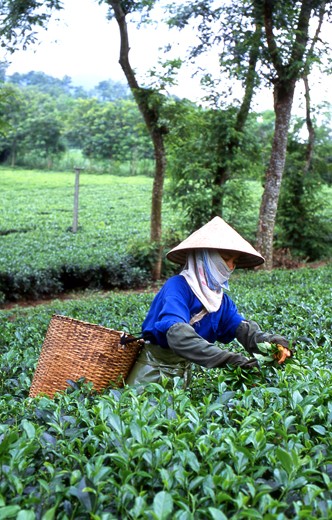Features on Asian Art, Culture, History & Travel
Archives
Archives > WORLD > Tea

Tea
The "Serviceable Herb"
SEE RELATED IMAGES @ PICTURES FROM HISTORY
“The King of China reserves to himself the duty on a certain herb which is drunk infused in hot water. This herb is sold in all the towns at high prices. Water is boiled and poured upon it. The drink so made is serviceable under all circumstances.” - Sulayman Abu Zayd as-Sirafi, 851 CE
Perhaps the most universal of all drinks but water, tea enjoys a unique popularity around the globe. From the Patagonian Pampas in Argentina, to the high plateau of Tibet, it serves as a restorative, an aid to digestion and a warming 'pick-me-up'. In the refined o-chaa ceremony of Japan, tea-drinking has attained an apex of cultural sophistication, whilst half a world away in Great Britain high tea, generally taken at mid-afternoon, distinguishes the drawing rooms of the rich and influential, royalty and commoner alike. No doubt about it, people everywhere hold tea in high esteem – but where did it originate, and who first thought of plucking the leaves of this sturdy shrub, and then infusing them in boiling water?
According to oral tradition, tea has been grown in China for more than four millennia. The earliest written accounts of tea making, however, date from around 350 AD, when it first became a drink at the imperial court. Around 800 AD tea seeds were taken to Japan, where regular cultivation was soon established. Just over five centuries later, in 1517, tea was first shipped to Europe by the Portuguese soon after they began their trade with China. In 1667 the Honourable East India Company ordered the first British shipment of tea from China, requesting of their agents "one hundred pounds weight of the best tey that you can get."
In 1826 the Dutch bought seeds from Japan for cultivation in their growing East Indian Empire, supplementing this effort in 1833 by imports of seeds, workers and implements from China. Meanwhile, also in the 1830s, the East India Company began growing tea on an experimental basis in Assam – the first one hundred boxes of Assamese tea reached Britain in 1840, and found a ready market. About the same time, tea seedlings were transplanted from Assam to Sri Lanka and planted in the highlands around Kandy. By the beginning of the present century tea was very much in fashion, with plantations established as far afield as Georgia in Europe; Natal, Malawi, Uganda, Kenya, Tanzania and Mozambique in Africa; Argentina, Brazil and Peru in South America; and Queensland in Australia. Despite this proliferation, however, Sri Lanka remains the largest producer of tea in the world today, with the fragrant black leaf the mainstay of its economy.
Tea is made from the young leaves and leaf buds of the tea plant, Camellia sinensis. Two principal varieties exist, the small-leafed China plant, known as C. sinensis sinensis, and the larger-leafed Assam plant, or C. sinensis assamica. The tea plant can grow to a height of around ten metres – a respectably large tree – but to facilitate the harvesting of the leaves it is usually trimmed to the size of a large shrub. This trimming of the shrub is said to extend the life of the tea plant, and some tea shrubs in Sri Lanka are believed to date back to the foundation of the first plantations nearly one hundred and fifty years ago.
The first usable tea leaves are produced sometime between the third and seventh year in the life of a tea shrub. The best tea is the so-called highland tea; it is grown 1,400–2,300 metres above sea level, where sunny days follow cold nights, and in between there is frequent fog. The flavour also depends on the speed of growth – the slower the growth, the better the flavour. As a rule, growth is slower in upland regions.
Teas are classified according to region of origin, as in China, Ceylon, Japanese, Indonesian, and African tea, or by smaller district, as in Darjeeling and Assam from India, Uva and Dimbula from Sri Lanka, Keemun from Chi-men in China's Anhwei Province, and Enshu from Japan.
Teas are also classified by the size of the processed leaf. Traditional operations result in larger leafy grades and smaller broken grades. The leafy grades are Flowery Pekoe, Orange Pekoe, Pekoe, Pekoe Souchong, and Souchong. The broken grades are: Broken Orange Pekoe, Broken Pekoe, Fannings, and Dust. Broken grades usually have substantial contributions from the more tender shoots, while leafy grades come mainly from the tougher and more mature leaves.
Still more important is the classification by manufacturing process, which results in the three categories of fermented (Black), unfermented (Green), and semi-fermented (Oolong or Pouchong) teas. Green tea is usually produced from the Chinese C. sinensis sinensis, and is grown mostly in Japan, China, and parts of Southeast Asia. The infused leaf is green, and the liquor is mild, pale green or lemon-yellow, and slightly bitter. Black tea, by far the most common type produced, is best made from Assam or hybrid plants. The infused leaf is bright red or copper coloured, and the liquor is translucent orange-brown and slightly astringent but not bitter, bearing the characteristic aroma of tea. Oolong and Pouchong teas are produced mostly in southern China and Taiwan from a special variety of the China plant. The liquor is pale or yellow in colour, as in green tea, and has a unique malty, or smoky, flavour.
SEE MORE TEA IMAGES @ PICTURES FROM HISTORY
Text by Andrew Forbes; Photos by Rainer Krack, David Henley & Pictures From History - © CPA Media
